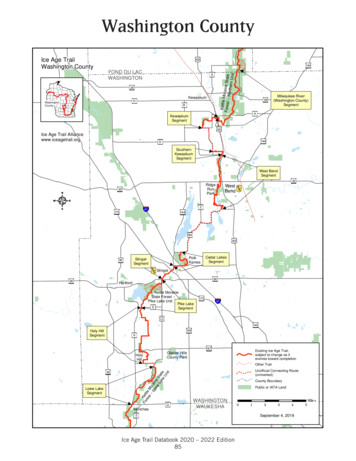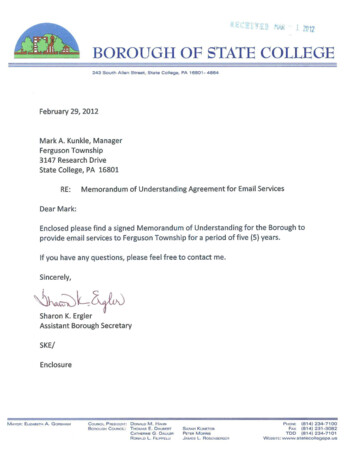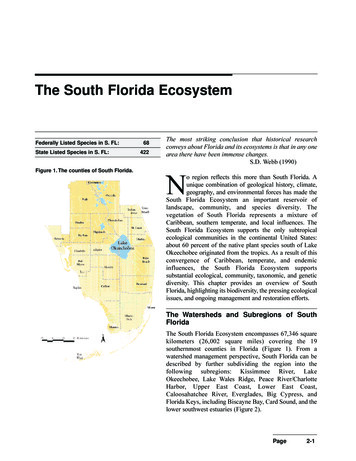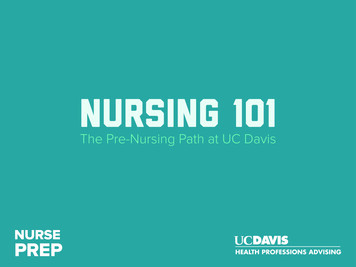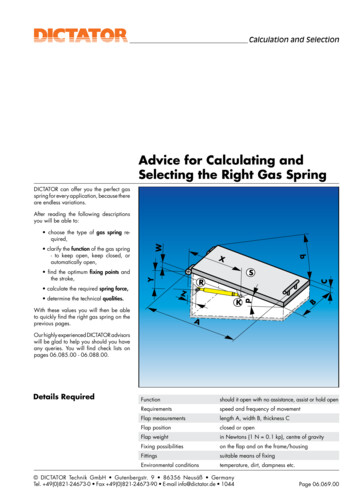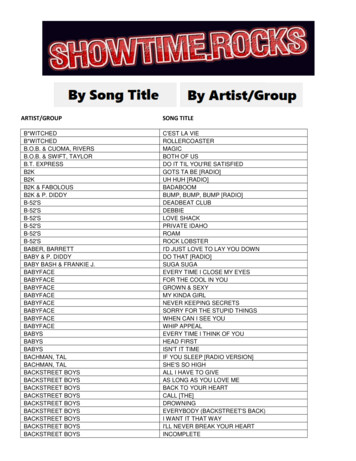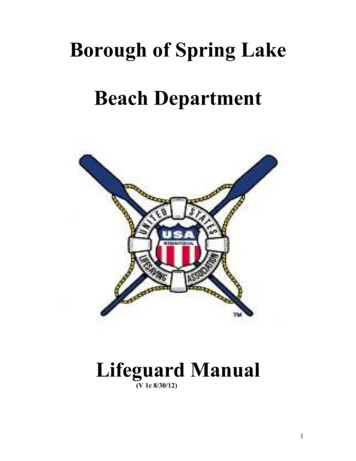
Transcription
Borough of Spring LakeBeach DepartmentLifeguard Manual(V 1c 8/30/12)1
TABLE OF CONTENTSPAGE 3: General OperationsPAGE 4: Special Access AreasPAGE 5 - 8: Supervisory Staff and Staff PositionsPAGE 8 - 9: First Aid USLA 21 hours curriculumPAGE 9-10: SLBP Rules Regulations and Policies.PAGE 10-11: Beach Areas and RegulationsPAGE 11-12: Weather and Environmental Closing ProceduresPAGE 12-13: Harassment PolicyPAGE 13-14: Sample EvaluationsPAGE 16-21: Daily Equipment, Radio Communication, Rescue Transmissions,Rescue Techniques and Procedures, Lost and FoundChild ProceduresPAGE 22-23: Article on STARR, responding to aquatic emergencies.PAGE 24 – 28: Article on Recognition and Observation of Potential Rescue Victimsin an Open Water Environment.PAGE 29-31: Spring Lake Code Red ProcedurePAGE 32: Rip Current InformationPAGE 33: Beach and Pool Lifeguard Requirements and Expectations.PAGE 34: Manual Sign Off Sheet2
General OperationsThe Spring Lake Beach Patrol protects two miles of public beach. The Beach Patrolstaffs twenty-four stands to cover this area. The stands are arranged in a manner thatallows for an overlapping field of vision, enabling cross coverage. Depending onstaffing, conditions, and weather, most stands are open for the normal bathing hours of9:00 am t0 6:00 pm. The following lists the names of these stands from north to south.Each area’s main stand is in bold print.Area Beaches and Stand NamesNorth BeachFar SurfersNear SurfersLorraineMiddleNorth BeachNorth EndLudlowNorth End MainTuttleBrighton and BreakersBrightonKayak BeachBreakersWashingtonCorresponding Street NamesPitney AvenueRemsen AvenueLorraine AvenueMonroe AvenueWorthington AvenueLudlow AvenueLudlow/Tuttle AvenueTuttle AvenueBrighton AvenueNewark AvenueWashington AvenueEssex and SussexFar MomboMomboE & S MainSouth End SurfersEssexSussexMercer AveSouth EndAtlanticSouth End MainSalemFar SalemAtlantic AvenueAltantic/SalemSalem AvenuePennselvania AvenuePier BeachAllaireA BeachBrownPier Beach MainYork AvenueBrown AvenueUnion Avenue3
Special Access AreasIn order to protect the safety of our bathers, the SLBD has assigned specific designatedareas for the following activities: fishing, surfing, and kayaking.Fishing: the following lists the designated areas for fishing during the normal bathinghours of 9:00 am to 6:00 pm. During these hours, fishing is strictly in prohibited in allother areas. The designated surfing areas are as follows: Pitney Avenue (Far Surfers) Jetty: north and south sidesWashington Avenue Jetty (Washington): north and south sidesNewark Avenue Jetty (Kayak): north side onlyPassaic Avenue Jetty (Mombo II) north and south sidesSussex Avenue Jetty: (E & S): north side onlyBy law, people actively fishing are not obligated to have a beach badge to access thedesignated fishing areas.Surfing: at the discretion of management, contingent on crowd and water conditions,surfing is permitted in the following areas during the normal bathing hours of 9:00 am to6:00 pm. During these hours, surfing in all other areas is strictly prohibited. Thedesignated surfing areas are as follows: Remsen Avenue (Far Surfers)Washington Avenue (Washington)Mercer Avenue (South End Surfers)Kayaking: at the discretion of management, patrons may launch and land kayaks onmost area beaches. Patrons interested in kayaking must check with the lifeguards andreceive permission before launching the kayak. The following lists the designated areasfor riding waves in a surf kayak during the normal bathing hours of 9:00 am to 6:00 pm.During these hours, kayaking in all other areas is strictly prohibited. The designatedkayaking areas are as follows: Brighton Avenue (Kayak Beach)Windsurfing: at the discretion of management, patrons may launch and operateWindsurfing equipment at the following designated areas. Patrons interested inwindsurfing must check with the lifeguards and receive permission before launching thekayak. The following lists the designated areas for operating windsurfing equipmentduring the normal bathing hours of 9:00 am to 6:00 pm. During these hours, operatingwindsurfing equipment in all other areas is strictly prohibited. The designated areas foroperating windsurfing equipment are as follows: Remsen Avenue (Far Surfers)Stand up Paddleboarding: If you have a tether on the board, you can do this in any ofthe surfing areas, if not only at Kayak beach if riding waves. You may launch if notriding waves at any of the surfing areas.4
Supervisory StaffCaptainLieutenantsLifeguard Crew ChiefsThe following are the job descriptions for each:Captain: the captain of the beach patrol reports directly to management. The followinglists the duties of the captain: Manage all aspects of the Beach PatrolSupervise all lifeguard personnel.Manage the web siteManage payrollManage junior guardsManage the tournament teamPerform duties of a lifeguard when requiredLieutenants: the lieutenants of the beach patrol report directly to the captain. Thefollowing lists the duties of the lieutenants: Report directly to the captainOversee the crew chiefsSupport the crew chiefs in the implementation of the beach patrol’s trainingprogramAssist the captain in managing the Junior Guard ProgramAssist the captain in managing the Tournament TeamPerform the duties of a lifeguard when requiredBeach Crew Chief Job Description:Crew Chiefs: the Lifeguard Captain will appoint a “crew chief” to be the immediatesupervisor of each of the Spring Lake Beach Patrol’s six designated areas. The crewchief is directly responsible for the overall safety and efficiency of the assigned area. Theduties of the crew chief are as follows: Enforce all SLPB rules, regulations, and policies Immediately follow the directives of the Beach Manager, Lifeguard Captain, andLieutenants Complete each day’s daily log and submit the daily log to the appropriate binder.The daily logs for the North Beach, North End, and Brighton area beaches will bestored in the North End Office; the daily logs for the Essex and Sussex, SouthEnd, and Pier area beaches will be stored in the South End Office. Monitor proper and timely setup of the required daily equipment for each stand inthe area, including all of the following:5
One radioThree torpedo cansOne line bucketTwo flag poles1 first aid kit1 set of ropes to mark off the stand’s areaFlagsOne whistle per lifeguardOne backboardOne floatable piece of equipmentTrain assigned personnel in proper and effective execution of approved rescueprocedures and life guarding techniques, including the following: identifying hazardous conditionsrecognizing distressed swimmerscommunicating with the publicmaintaining a designated water area through use of a whistle, handgestures, and placement of flagsappropriate, clear and professional radio communicationInitiating and executing SLBP rescue proceduresAssign water patrol of crew as necessary.Train assigned personnel in the function, maintenance, safestorage, and safe use of all lifeguard equipment, including torps,lines, rescue boards, kayaks, and boatsComplete the United States Lifesaving Association’s mandatorytwenty hours of first aid training with the support of theEmergency Medical Technicians Design (with the approval of the Captain) and maintain a schedule for the season,assigning one “veteran” guard to each area stand five days a week Each morning, perform at least one daily radio check with each stand in the area Evaluates the assigned area’s personnel and report strengths and weaknesses tomanagement; all disciplinary issues need to be documented in accordance withthe agreement between the Borough of Spring Lake and the Guards of SpringLake Create and supervise mandatory morning workouts for the crew; these are notoptional—if a crew member can not complete the day’s assigned training, thenhe/she will be sent home for the day Perform the duties of a lifeguard when requiredLifeguards: Spring Lake lifeguards are an outreach to the surrounding community. Ourbeach embraces a “team” concept which can show itself in many ways. This can easily beseen in the coordination of rescues, communication between lifeguards and supervisors,as well as the public. Spring Lake guards are expected to possess above average personal6
attributes while on duty and off duty. They should be able to interact with respect andhonesty with their co-workers and the public.The following lists the prerequisites for becoming a lifeguard: Swim 500 meters in under 9:45 minutes for beach guards. Swum 500 meters in under 10:00 for pool guards. Run 1 mile in under 10:00 minutes Present current and official cards for CPR/AED for the Professional Rescuer andbasic First Aid (a list of acceptable certifications can be found athttp://www.springlakeguards.com); copies, duplicates, or cards from otheragencies will NOT be accepted. Pool guards have to have LGT additionally. Commit to working from Memorial Day through Labor Day; as per the agreementbetween the Boro of Spring Lake and the Guards of Spring Lake, employeesreturning to college before Labor Day may end their season three days beforethe start of class.The following lists the duties of a lifeguard: Immediately follow all directives from the Management, the Captain, theLieutenants, and the Crew Chiefs. Maintain a safe bathing area at all times Complete the SLBP’s Open Water Lifeguard Training Program, including dailyworkouts and rescue drills with the crews, first aid training with the EMT’s, andtrain independently in the afternoons when allowed Complete the USLA’s mandated twenty-one hours of first aid training –curriculum as listedTOURNAMENT COORDINATOR(S) Evaluate all interested Spring Lake Guards that are interested in participating inlocal, regional, and national tournaments.Arrange practices for the tournaments and communicate the information to theguards in a adequate time frame for them to attend.Meet with Crew Chiefs to discuss guards interested in and/or participating intournaments to make sure beach coverage is maintained effectively and safely.Submit paperwork for Spring Lake’s hosted tournament to the Chief Lifeguard forborough approval.Submit paperwork for registration of Spring Lake guards for regional and nationaltournaments to the Chief Lifeguard where necessary to submit to USLA.Submit paperwork and coordinate with local area beaches information necessaryfor participation in local tournaments.7
Submit a list of dates and maintain the list if the dates change to the ChiefLifeguard of equipment needs from the Director of Public Works. For examplethe use of the truck and tailors needed to move equipment.Gather and maintain all necessary equipment needed for each tournament.Update and maintain information on the web site to get information out to theguards.Spring Lake Beach PatrolFirst Aid in the Aquatic EnvironmentCurriculum and Time AllocationThe identified curriculum topics are required training for all open water lifeguards.Under the supervision of the SLBP Chief, lieutenant, and EMTs, a schedule iscoordinated with each beach sections crew chief. All trainings are under the direction ofthe Lifeguard captain and beach management. USLA OWL manual and the ARCLifeguarding manual are the primary resources for the content development.Curriculum Requirements: 21 hours per USLA standards (not including CPR).Curriculum TopicUniversal Precautions andDisease PreventionTime Allocation1.5 hourIdentify conditions, signsand symptoms under whichLifeguards are to suspecthead, neck or spine (back)injuries.1 hourCategorize methods ofhandling head, neck andspine injuries.Skill practice of saferemoval and boarding ofspinal injuryInjuries caused by marinelife and other commonorganisms in theenvironment1 hour.Hawaiian/USSTHead Splint methods1.5 hoursSee above1 hourJelly fish, Rays, etc.Bee stings,FA training to includeexplanation of anaphylaxisand allergic reaction.Heat related emergencies1 hourHeat cramps, exhaustion andstroke.Sunburn and CancerAwarenessHypothermia and shock1 hourPrevention, screening,treatmentTreatment. Pulse checkextended.1 hourNotesBasic prevention – gloves,protective equipment, faceshields, resuscitation masks,clean upVictimEnvironmentLand and Sea8
Review Rescue Breathingand Breathing Emergencies2 hoursARC/AHAInfant/Child/AdultObstructions, conscious,unconscious.First Aid in the Aquatic EnvironmentCurriculum and Time AllocationCurriculum TopicReview Near DrowningTime Allocation1 hourReview O2 Admin.2 hoursWounds and BleedingEmergencies1.5 hoursMuscle, Joint, Bone Injury1.5 hoursNotesSigns and symptomsGrade and FAEMT/ALSEquipmentSafetyUseLacerations, puncturewounds, scalp injuries,severe bleeding, universalprecautionsImmobilizationSimple splint – anatomicalDrugs, Alcohol, Poisoning, 1.5 hourand MedicinesSigns and symptoms,Police support,Psych assessmentMed alert tagsOther Sudden Illness/Loss of 1 hourconsciousnessStroke, Seizure, DiabeticemergencyEMT/ALS – 911 callsFollow up, Debriefing, of 1.5 hourFA callsReport details,Consult with CC and SLBPmanagement. Attend training sessions on information about Blood Borne PathogensAttend training sessions on information about Sexual Harassment in theworkplace.SLBP Rules, Regulations, and Policies Beach lifeguards will work a nine hour day, from 9:00 am to 6:00 pm, with a onehour lunch break that will be coordinated by the crew chiefs in order to maintainproper and effective coveragePool lifeguards will work a varied schedule to meet the needs of pool operationhours.EMT will cover hours of operation of the pools and beach.9
Safety Certification Officer will work “as needed” to properly certify the beachemployees.All employees will maintain current certifications for their specific job position.Deviations from this schedule can be arranged and will be discussed on anindividual basisUniformsSafe use of equipmentEvaluationsBeach Regulations and AreasThe following regulations govern our beaches and water activities:BathingSwimming is permitted at all beaches designated with two green flags. The bathing areais the area between the two flags.Swimming: Moderate surf conditions, exercise cautionNo water entry strong surf, strong currents Boogie boards/RaftsBoogie Boards/Rafts are permitted in swim areas and may be designated with blue flags. Boogie board with finsIn certain surf conditions lifeguards may require fins with the use of a boogie board.At the discretion of the chief of the lifeguards or beach manager, the following wateractivities are permitted as designated:SurfingRemsen Ave. area of North BeachWashington Ave. area of the Breakers section, North End BeachMonmouth Avenue area of South EndKayakingKayaking is only permitted at the following beaches and while there is no flag colorassigned, signs may be posted at the beaches noted. Crew chiefs may permit launchingand landing (only – no wave riding) of kayaks at other beaches if environmental andattendance conditions are favorable.10
Brighton Ave. area of North EndMercer Ave. area of Essex and SussexWindsurfing/Kite surfingAt the discretion of the Chief of the Lifeguards or Beach Manager, windsurfing/kitesurfing is permitted only at the Brighton Ave. Beach of North End and Near/Far SurferBeach of North Beach. Windsurfing is not permitted in any other area.Notes:Signs are posted with information and flag colors at the entry steps to all beaches. It isimportant that guards know the bathing regulations and areas designated for activities, sothat they may enforce such.At the Bath and Tennis club beach, B&T lifeguards are responsible for surfers andkayakers and other activities in the Jersey to Morris Ave. area.The chief of the lifeguards may extend her authority to the crew chiefs for decisions onthe beach.Scuba diving (that is full gear self contained underwater breathing apparatus) is permittedwith the following guidelines – permission must be cleared through the police departmentand a letter given, scuba divers must check in with the lifeguards for directions andlocation, all safety requirements, and maritime laws governing scuba must be fulfilled(example - divers must have a dive flag that is visible from surface of water). In addition,Scuba divers must be no fewer than two – buddy system in place. Scuba is not permittedin the fishing areas (see fishing beach section).Weather and Environmental Closing ProceduresWeather and environmental conditions in outdoor facilities such as beaches relate directlyto the safety of swimmers. This procedure primarily deals with Lightning and Thunderstorms; however, other environmental conditions may be covered by the same guidelines.In general lifeguards should be aware of weather conditions and their environment andconsistently monitor such, to maintain patron and their own safety.The following procedures are in place:In case of a thunder or lightning incident, the lifeguard is to call in the occurrence to theircrew chief. Crew chiefs will verify the report and radio the Chief of the Lifeguards.Chief of the Lifeguards will instruct the Lifeguards on the course of action to be taken.Information will be gathered from visual, audio, and technical areas (lightening detectoror computer radar). If the Chief is not available one of the lieutenants will do this.(Standby, or clear the pools, beach and water of all swimmers are some examples).When lightening is within the 12-24 mile range, the guards will be instructed to takedown any non-essential equipment such as flags or umbrella’s. The gate attendants andbadge sellers will also stop their activity and take shelter. USLA recommends that an “all11
clear” should occur if lightening occurs within 10 miles of the area, and at that time thebeach and pools will clear for 30 minutes. Upon any lightening activity within the 10miles, the 30 minute wait will re-start.When the Chief calls for evacuation of the pools, beach and water, lifeguards are tosignal by whistle (one long whistle blast) and torp (hold torp over head and point to theboardwalk) to all patrons that they are to seek shelter. Specifically guards are to instructpatrons, that “dangerous lightning and storm activity has been reported and for safetyreasons everyone must seek shelter off the beach”.Once the water and beach are clear, Lifeguards are to seek shelter for their own safetyand monitor the radio for an “all clear” from the Chief.Guards are to continue to monitor activity on the beach and in the water, in case anyonedoes return to the beach before the “all clear”. If they do, they will radio the Chief whocan then get in touch with local police to handle the situation.If any lifeguard feels they need to leave the beach area for their own safety they maydo so but must notify supervisor(s) when they do so.An all clear will be called when 30 minutes have passed without any repeat incidents ofThunder or Lightning.Notes:According to the National Weather Service and Lightning Safety Council- Thunder and /or Lightning are indistinguishable; in other words they are the same and we do not haveto have both to be considered a weather incident.If the Chief or Lieutenant are not present, the crew chief of the section reporting theincident will monitor the time and weather.It is a good idea to listen for weather reports prior to the start of the day.If a patron is uncooperative or refuses to leave the beach, radio for back up from the crewchief and then leave the beach to maintain personal safety.When you seek shelter stay away from tall objects that attract lightning, do not useshowers,Pools and offices will follow same procedures; however, the pool lifeguards will radiofrom the offices to the Chief.Harassment PolicyThe Spring Lake Beach Patrol and borough is committed to a workplace that is free ofdiscrimination and harassment based on race color, religion, age, sex, national origin,disability or any other basis protected by federal, state or local laws. In an effort toprevent such illegal harassment or discrimination from occurring, we will communicatethis policy to every employee. No employee of this company is exempt from this policy.12
Examples of misconductDiscrimination or harassment based on race, color, religion, age, sex, national origin,disability, or any other legally protected status is considered a form of employeemisconduct. Examples of such misconduct may include, but are not limited to: A request or demand for sexual favors accompanied by a threat concerning anindividual’s employment status or a promise of preferential treatment. Unnecessary and unwelcome touching of an individual for example- patting,pinching, hugging or repeatedly brushing against another individual’s body; or Offensive jokes, comments, slurs, e – mail, memos, faxes, cartoons or gestures. Physical violence or threats of any kind.Disciplinary action, up to and including termination, may be taken against any employeeengaging in this type of behavior. Disciplinary action may also be taken against anyemployee engaging in this type of behavior. Discipline action may also be taken againstany employee who in bad faith makes a false or dishonest claim of harassment ordiscrimination. Any supervisor or manager who has knowledge of such behavior yet failsto take appropriate action is also subject to discipline.Reporting complaintsAny employee who believes he or she is being discriminated or harassed based on any ofthe grounds stated above should report it immediately to his/her direct supervisor or tothe human resources department (or manager). The company will investigate thecomplaint, make a written determination of its conclusion and when appropriate prepare aplan of action to correct the problem and prevent reoccurrence. The company shallinform the complaining employee of its determination.Non retaliationUnder no circumstances will an employee be penalized for reporting what the employeebelieves in good faith to be harassment under this policy. If you believe that you arebeing retaliated against for bringing a complaint of harassment or discrimination, youshould report such conduct immediately to your direct supervisor or to the humanresource department (or manager). Any supervisor or manager who retaliates against anemployee for making a complaint shall be subject to disciplinary action up to andincluding termination.If you have questions about the policy, please contact your supervisor or the humanresources department (or manager). The success of our policy depends, in significantpart, upon the understanding and cooperation of all our employees.Evaluation Forms: Below are some examples of lifeguard evaluation forms that can beused.BOROUGH OF SPRING LAKE BEACH DEPARTMENTLIFEGUARD EVALUATIONName of Lifeguard:Date:13
Location:Evaluation Codes:E: Exemplary S: Satisfactory U: Unsatisfactory NI: Needs Improvement NA:Not Applicable1) Appearance2) Adherence to dress code3) Punctuality4) Conformance to work schedule5) Maintains proper coverage of assigned area(s)6) Overall Training/Workout Performance7) Cooperation with Supervisory Personnel8) Cooperation with colleagues9) Courtesy to Public10) Maintains equipment properly11) Uses communications effectively and properly12) Follows and enforces municipal rules, policies, and ordinances13) Ability to remain calm in stressful situations14) Ability to render first aid/C.P.R to those in need15) Ability to observe water/beach/pool safety situations16) Efforts in training and utilizing lifeguard water safety equipment17) Overall job performance*Letter(s) of Commendation on file YES NO*Letter(s) of Discipline on file YES NO*COMMENTS:Eligible for rehire in as a lifeguard: YES NOEvaluator’s Signature DateEmployee’s Signature DateSpring Lake Beach PatrolSeason Year End EvaluationEmployee:Area:Evaluation Codes14
AP (Advanced Proficient), P (Proficient), PP (Partially Proficient), NP (Not Proficient)Follows and enforces department policy and procedure:Explanation:Demonstrates effort and participation in daily training program:Explanation:Interacts courteously and professionally in dealing with patrons:Explanation:Actively engages in preventative lifeguarding:Explanation:Communicates effectively with colleagues and supervisors:Explanation:Thank you for your service at Spring Lake for the summer. In looking forwardto the season, your position is tentatively as follows:Ocean LifeguardPool LifeguardEMTUndecided/OtherThis assignment is contingent upon current certifications and passing physicalrequirements.Thank you,Janet CarbinChief LifeguardDaily Equipment: the following lists the daily equipment required for correct standsetup: One operational radioOne whistle per lifeguardThree torpedo cansOne line bucket1 set of ropes to mark off the stand’s area15
Two flagpoles with the appropriately colored flagsOne first aid kitOne spinal boardOne floatable piece of equipment: kayaks, rescue boards, boats, and jet skisRadio Communications: for the duration of bathing hours, each open stand will beequipped with a radio. The radio functions as the primary means of communications.The radio enables guards to communicate with other stands, crew chiefs, EMT’s, theLieutenants, the Captain, and Management. Additionally, local law enforcementagencies closely monitor SLBP communications over the radio.The following lists guidelines for proper and effective use of the radio:1. Basic Usage: Working the radio: press down the transmission button and hold it fortwo seconds (transmissions are on a slight delay because of the use of arepeater system.) Remember to shield the radio from the windTransmitting: identify the stand/location making the transmission; thenidentify the stand/location receiving the transmission. Note the followingexample, “Near Surfers to North Beach)Receiving: identify the stand/location receiving the transmission; thenauthorize the transmission by saying “go ahead” and repeat the name ofthe stand sending the transmission. Note the following example, “This isNorth Beach. Go ahead Near Surfers.”Ending the transmission: after receiving stand concludes thetransmission by stating, “copies.” Note the following sampletransmission:Near Surfers: “Near Surfers to North Beach”North Beach: “This is North Beach; go ahead Near Surfers”Near Surfers: “Can you send the crew chief down here?”North Beach: “She is on her way.”Near Surfers: “Near Surfers copies”North Beach: “10-4.”2. Rescue Transmissions:North Beach: “Rescue North Beach; one torp in the water. Standby.”Nearby Crew Stands: Will wait for further direction to either “bump” personnel asneeded, send a rescue line or torp, or to cover the stand where the rescue is occurring.All guards on each side of the rescue should be standing in order to give a visual cuethat there is a “situation” at that stand.3. Emergency Transmissions: a variety of situations may occur that require anemergency transmission. These situations include: serious medical issues,including stroke, heart attack, loss of consciousness, severe bleeding, etc; amissing persons report; hazardous water conditions; and emergencies requiring16
immediate police attention. The following are guidelines for emergencytransmissions: During an emergency transmission, all other radio communication must cease(except other emergencies) Emergency medical situations require a call to an EMT and, if necessary, acall to either the North End Office or South End Office—depending on thelocation of the incident—to request an ambulance; When requesting anambulance, the lifeguard must provide the office with the correct streetname for the location of the stand The sudden emergence of hazardous water conditions must be reportedfollowing the appropriate chain of command: Crew Chiefs, Lieutenants,Captain, and Management. Emergencies requiring immediate police attention (such as a fight on thebeach) should be reported to either the North End Office or South EndOffice—depending on the location of the incident; be clear and specific aboutthe nature of the incident Procedures for reporting a missing person can be found in that section of thismanual4. FCC Regulations: the following lists some basic FCC guidelines regulating radiotransmissions No person shall transmit any unnecessary, unidentified, or superfluous radiotransmissions No person shall transmit any obscene, profane, or offensive language No person shall interfere or cause interference with any radio transmissionRescue Techniques and ProceduresSpecial Rescue situationsJetty rescues and rocks - Jetty and rock rescues can be a frightening situation, howeverwith proper training and awareness of how to maintain personal safety lifeguards canrespond and assist patrons. Jetty rescues usually result from two events – a. patrons haveclimbed or got on the rocks from the beach and the returning tide has trapped them on thejetty; and b. current or surf conditions have carried swimmers on to the rocks. Thefollowing steps are to be undertaken:1. Personal/lifeguard safety is priority number 1. To this end, lifeguards should donany and all protective equipment available. Most likely this will mean wearingswim fins, and taking a torp; if available gloves and wet suit are highly desirable.17
2. The primary lifeguard or rescuer should swim to a position in the water that isadjacent to the victims on the jetty. Talk to the victim, assess and determine theircondition. Do not swim to or on jetty right away. While treading water, observefor current and wave action. Upon determining water action, try to talk thevictim/s off the rocks and have them swim to you and your torp for safety.Instruct the victim on what you want them to do.3. If you are not able to talk the victims off the jetty, you may have to go in and onto the rocks. Again, watching the water action and timing the waves is critical.Go in on the back side of a wave or in between a set. Keep the torp and your fee
the Lifeguard captain and beach management. USLA OWL manual and the ARC Lifeguarding manual are the primary resources for the content development. Curriculum Requirements: 21 hours per USLA standards (not including CPR). Curriculum Topic Time Allocation Notes Universal Precautions a


